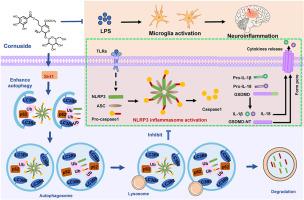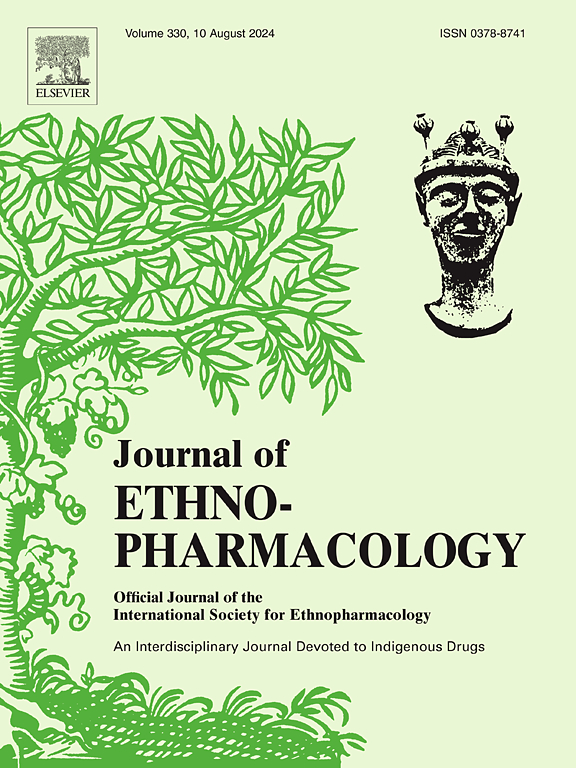Cornuside ameliorates LPS induced cognitive dysfunction and microglial NLRP3 inflammasome activation by enhancing Sirt1-mediated autophagy
IF 5.4
2区 医学
Q1 CHEMISTRY, MEDICINAL
引用次数: 0
Abstract
Ethnopharmacological relevance
Corni fructus are the fruits of Cornus officinalis Sieb. et Zucc. and is widely used in traditional Chinese Medicine for the treatment of dementia. Cornuside, derived from Corni fructus, has been shown to be effective in improving cognition of AD mouse.
Aim
In the present study, we investigated the effect of cornuside on cognitive dysfunction and microglial NLRP3 inflammasome activation, as well as explored the underlying mechanism with respect to Sirt1 and autophagy.
Methods
AD mice were established and then treated with cornuside (3, 10, and 30 mg/kg) for 2 weeks. A series of behavioral tests were performed to assess cognition, including the Morris water maze, Y maze, nest building, step-down and step-through tests. Nissl staining was used to evaluate neuronal structural damage. LPS-stimulated BV2 cells were used for in vitro experiments. The anti-inflammatory effects of cornuside on cytokines and NLRP3 inflammasome activation were assessed using ELISA, RT-PCR, immunohistochemistry, western blotting, and immunofluorescence assays. To further elucidate the relationship between Sirt1, autophagy, and NLRP3 inflammasome activation, EX527 and 3-MA were used to inhibit Sirt1 and block autophagy flux in vitro, respectively.
Results
Cornuside significantly improved various behavioral performance and inhibited NLRP3 inflammasome activation in LPS-induced mice, as evidenced by decreased levels of NLRP3, ASC, pro-caspase1, caspase1, pro-IL-1β, IL-1β, GSDMD, GSDMD-NT and IL-18. Similar inhibitory effects of cornuside on NLRP3 inflammasome activation was also detected in LPS stimulated BV2 cells. The involvement of Sirt1 and autophagy were further explored in-vivo and in-vitro, revealing that cornuside increased the expression of Sirt1 and enhanced autophagy, with decreased SQSTM1/p62 and increased LC3BII. However, the inhibitory effect of cornuside on NLRP3 inflammasome activation was abrogated by 3-MA, and the effects of cornuside on promoting autophagy and inhibiting NLRP3 inflammasome activation was abolished by EX527.
Conclusion
Cornuside exerts therapeutic effects on LPS induced AD mice by inhibiting microglial activation and NLRP3 inflammasome overactivation. And Sirt1 mediated autophagy activation is a vital mechanism by which cornuside degrades NLRP3 inflammasome, thereby alleviating neuroinflammation and improving cognitive function.

角苷通过增强sirt1介导的自噬,改善LPS诱导的认知功能障碍和小胶质NLRP3炎性体活化。
民族药理学相关性:山茱萸是山茱萸的果实。调查。在中医中被广泛用于治疗痴呆。从山茱萸中提取的山茱萸苷已被证明能有效改善AD小鼠的认知能力。目的:在本研究中,我们研究了山角苷对认知功能障碍和小胶质细胞NLRP3炎性体激活的影响,并探讨了Sirt1和自噬的潜在机制。方法:建立AD小鼠,分别给予山茱萸苷(3、10、30 mg/kg)治疗2周。通过Morris水迷宫、Y迷宫、筑巢、降压和穿越等一系列行为测试来评估大鼠的认知能力。尼氏染色评价神经元结构损伤。体外实验采用lps刺激的BV2细胞。采用ELISA、RT-PCR、免疫组织化学、western blotting和免疫荧光法检测山羊角苷对细胞因子和NLRP3炎性小体活化的抗炎作用。为了进一步阐明Sirt1、自噬和NLRP3炎性体活化之间的关系,我们在体外分别用EX527和3-MA抑制Sirt1和阻断自噬通量。结果:山茱萸苷显著改善lps诱导小鼠的各项行为表现,抑制NLRP3炎性小体的激活,其表现为NLRP3、ASC、前caspase1、caspase1、前IL-1β、IL-1β、GSDMD、GSDMD- nt和IL-18水平的降低。在LPS刺激的BV2细胞中也检测到玉米角苷对NLRP3炎性体活化的类似抑制作用。在体内和体外进一步探讨Sirt1与自噬的关系,发现玉米苷增加Sirt1的表达,增强自噬,降低SQSTM1/p62,增加LC3B II。然而,玉米角苷对NLRP3炎性小体激活的抑制作用被3-MA取消,玉米角苷促进自噬和抑制NLRP3炎性小体激活的作用被EX527取消。结论:山茱萸苷通过抑制小胶质细胞活化和NLRP3炎性体过度活化对LPS诱导的AD小鼠有治疗作用。Sirt1介导的自噬激活是玉米苷降解NLRP3炎性体,从而减轻神经炎症,改善认知功能的重要机制。
本文章由计算机程序翻译,如有差异,请以英文原文为准。
求助全文
约1分钟内获得全文
求助全文
来源期刊

Journal of ethnopharmacology
医学-全科医学与补充医学
CiteScore
10.30
自引率
5.60%
发文量
967
审稿时长
77 days
期刊介绍:
The Journal of Ethnopharmacology is dedicated to the exchange of information and understandings about people''s use of plants, fungi, animals, microorganisms and minerals and their biological and pharmacological effects based on the principles established through international conventions. Early people confronted with illness and disease, discovered a wealth of useful therapeutic agents in the plant and animal kingdoms. The empirical knowledge of these medicinal substances and their toxic potential was passed on by oral tradition and sometimes recorded in herbals and other texts on materia medica. Many valuable drugs of today (e.g., atropine, ephedrine, tubocurarine, digoxin, reserpine) came into use through the study of indigenous remedies. Chemists continue to use plant-derived drugs (e.g., morphine, taxol, physostigmine, quinidine, emetine) as prototypes in their attempts to develop more effective and less toxic medicinals.
 求助内容:
求助内容: 应助结果提醒方式:
应助结果提醒方式:


